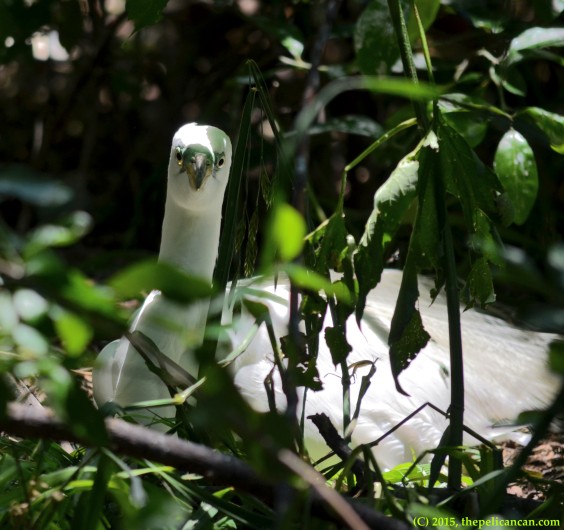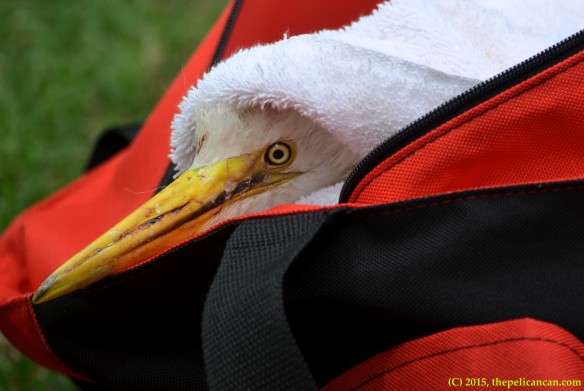In mid-May last year, I was at the rookery at UT Southwestern. Lots of eggs had hatched, and wherever I went, I could hear the rhythmic croaking of hungry great egret chicks begging for food.
I rounded a corner and saw a small white fuzzy mass in the grass. It was a baby egret. Once I called Rogers and learned that baby egrets receive no parental help if they get knocked out of the nest, I captured the chick. She was my first-ever bird rescue.
My first rescue this year came earlier than I expected, and it involved an adult. She was lying in some weeds outside the rookery. She looked as though she were lying on a nest, except she was on the ground.
I cautiously walked toward her to see how she reacted. She reared back as though she were about to strike and flapped a wing as if she were trying to get up, but she stayed on the ground. I didn’t have any eye protection with me—I didn’t think I would need to do any rescues so early in the season—so the prospect of trying to retrieve a full-grown egret freaked me out. Luckily, I was able to collect her without incident. The volunteer at Rogers who examined Number One thought that she had hurt her back because she wasn’t able to use her legs but predicted that she should recover.
I am very much pro-intervention for hurt birds. The groundskeeping employees at UT Southwestern are told to “let nature take its course” if they see abandoned chicks wandering around. I disagree with that philosophy. Birds don’t live in an unsullied state of nature. They live in the human world. Birds smash into windows, are struck by cars, get tangled in fishing line, are killed by house cats that people allow outside, and are intentionally hurt by humans. Human commercial activities and political decisions, however, affect birds on a much greater scale. A bird’s access to food, water, loafing sites, and breeding sites is dependent upon humans. Construction can clear valuable habitat. At UT Southwestern, not only has the majority of the rookery been destroyed, but construction interfered with water drainage patterns through the rookery, which means that there is less water available for the nesting birds. Carrollton once obliterated an active rookery during nesting season. And what about the “oopsies” Dallas keeps committing in the Great Trinity Forest, like the draining of a wetland pond? We’re very lucky to have Ben uncovering and publicizing the city’s misdeeds, but it doesn’t stop the city from messing up in the first place.
Digging and Draining Raises Concerns About City’s Care of Great Trinity Forest
Birds have to navigate the human world in order to survive. If an egret or a black-crowned night heron chick is able to defy the odds by managing to get outside the perimeter of the rookery after falling out or being forced out of its nest, I’m going to rescue it.
Like Number Two.
When I first saw Philoctetes the pelican, I really wanted to take her to Rogers so they could see what as wrong with her leg. After talking with a few people, I decided not to try. Throughout the winter, when I saw pelicans that looked as though they were having trouble—such as a pelican that had been shot by a human, a pelican with a horrible-looking infection on her gular pouch, and a pelican with a fishing lure caught near her leg—I tried to keep an eye on them in case they got worse. In a situation where a rescue would be difficult, such as with large and social birds like pelicans, I now think that a bird should be left alone unless an injury starts interfering with her ability to feed or protect herself. Watchful waiting.
Lady Katherine is alive today because people decided not to let nature take its course. So is a Muscovy duck that Ben rescued and literally breathed life into. When I see an adult great egret fishing at the spillway, I sometimes wonder if it is one of the chicks I rescued last year.
And, of course, tons of birds are alive because of the good work done at Rogers.
Fuck letting nature take its course if there’s a chance to help a bird that is distressed.


